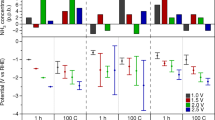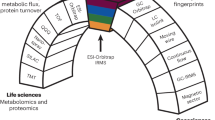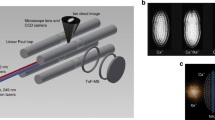Abstract
The importance of isotope separation has increased due to the wide use of isotopes in both energy- and life-science-oriented applications1. This, coupled with our observation2 that the solution electron affinities3 of perdeuterated hydrocarbons are less than those of corresponding undeuterated species, led us to investigate the possibility of isotopic enrichment through electron exchange equilibria. Here we report the observation that nitrobenzene containing 15N has a higher affinity for solvated electrons in liquid ammonia than does nitrobenzene containing the most common isotope of nitrogen (14N). When an equal-molar mixture of 14N-nitrobenzene (PhNO2-14N) and 15N-substituted nitrobenzene (PhNO2-15N) is added to a solution of solvated electrons in liquid ammonia, the anion radical of PhNO2−15N is formed predominantly over that of PhNO2-14N. Furthermore, as the chemical and physical properties of the resulting anion radicals (PhNO2-15N−. and PhNO2-14N−.) are very different from those of the neutral molecules, the electron exchange equilibrium between these two isotopic species can be utilized to enrich samples selectively with respect to the two isotopic species. Analogous results have been observed for the case of benzophenone-12C and benzophenone-13C (carbonyl 13C).
This is a preview of subscription content, access via your institution
Access options
Subscribe to this journal
Receive 51 print issues and online access
$199.00 per year
only $3.90 per issue
Buy this article
- Purchase on Springer Link
- Instant access to full article PDF
Prices may be subject to local taxes which are calculated during checkout
Similar content being viewed by others
References
Tanaka, N., Yamaguchi, A. & Arki, M. J. Am. chem. Soc. 107, 7781–7782 (1985).
Stevenson, G. R., Espe, M. P. & Reiter, R. C. J. Am. chem. Soc. 108, 532–533 (1986).
Stevenson, G. R. & Hashim, R. T. J. Am. chem. Soc. 107, 5794–5795 (1985).
Lawler, R. D. & Fraenkel, G. K. J. chem. Phys. 49, 1126–1139 (1969).
Lawler, R. G. & Tabit, C. T. J. Am. chem. Soc. 91, 5671–5672 (1969).
Khatkale, M. S. & Devlin, J. P. J. chem. Phys. 70, 1851–1859 (1979).
Author information
Authors and Affiliations
Rights and permissions
About this article
Cite this article
Stevenson, G., Espe, M., Reiter, R. et al. Isotopic enrichment by electron exchange. Nature 323, 522–523 (1986). https://doi.org/10.1038/323522a0
Received:
Accepted:
Issue Date:
DOI: https://doi.org/10.1038/323522a0
This article is cited by
-
Isotopic effect in the reaction of materials with oxygen
Soviet Atomic Energy (1990)
Comments
By submitting a comment you agree to abide by our Terms and Community Guidelines. If you find something abusive or that does not comply with our terms or guidelines please flag it as inappropriate.



